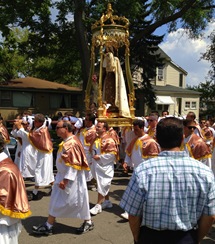What do pignoli nut cookies have to do with Christian worship? More than you may realize. Because human life is embedded in historical context—in distinct ethnicities, geographies, and socio-economic neighborhoods—we encounter and express Christian faith differently, a fact that asserted itself with renewed vigor this summer when I visited the Procession of our Lady of Mount Carmel in Melrose Park (near Chicago), an Italian feast dating back to 1894.
If you grew up Protestant and weren’t surrounded by Catholic neighbors with names like Giuseppe and Vincenzo, you may not be familiar with religious processions. The event typically begins with a Mass, after which the patron saint (in this case, an eight-foot shrine of Mary under the banner "Our Lady of Mount Carmel") is paraded through the streets. Moms and dads lift infants to be touched by the shrine, photographs of deceased family members are displayed in honor of their memory, elderly women recite the rosary in Italian and beat their breasts exclaiming Mea culpa, mea culpa, mea maxima culpa (Latin for "my fault, my fault, my most grievous fault"). After two hours of meandering behind the Knights of Columbus brass instrument band, the shrine is returned to the church. Parishioners then proceed to enjoy an annual feast amid fireworks, rides, and all manner of Italian delicacy.
Catholics trace the origins of processions to ceremonies in the Old Testament such as the carrying of the Ark of the Covenant (2 Sam 6; 1 Kings 8), and, in the New Testament, the triumphal entry of the Lord Jesus into Jerusalem. There are also examples from early church history when funeral processions of Christians were carried out with solemnity, such as what we see in Tertullian’s De Praescriptione Haereticorum xliii (On the Prescription of the Heretics). But such history is the furthest thing from the mind of Mamma Leone and her family. If you were to inquire into their motivation for joining the procession, they would probably reply, "It is who we are."
Candid Observations
I must confess, it was fascinating to watch this event as an evangelical Protestant. Having grown up as a good (Italian) Catholic boy attending New York’s equivalent, Feast of San Gennaro, I found myself dual-processing. Here are some observations.
To begin with, given my work at the Catholic/Protestant intersection, it is my goal to be exceedingly charitable toward Catholics. It’s a courtesy we ourselves appreciate (to not be associated with the ludicrous examples of evangelicalism on late night religious television) so it is reasonable—to say nothing of the requirement of Christian virtue—to extend the same sort of kindness to others. Still, I must admit, I have zero tolerance for the veneration of Mary common to these events. I understand the proper Catholic distinction between veneration of Mary (hyperdulia) and worship of God (latria), but this distinction gets lost on most laypeople. Such devotion strikes me as idolatrous, and, equally problematic, it eclipses the role of Christ as the one mediator between God and man (1 Tim 2:5).
That said, I allowed myself to drift back in time for a moment and see the event through the eyes of an adolescent guido from Long Island. There I was, figuratively, in my Sergio Tacchini sweat suit, gold chain dangling from my neck, pompadour hair, and pinky ring (actually, I still wear the pinky ring) viewing the culture from the inside. I saw affection between parents and children, family identity that transcended one’s individual self, congregational singing, public prayers of repentance, and a community animated by personal warmth. None of this is the gospel; nor does it compensate for doctrinal deficiency. It is, however, the fruit of the gospel, insofar as Christian values have shined into human cultures to give them shape and definition.
Driving home from the Melrose Park, I wondered what it would look like for evangelicals to affirm and celebrate gospel fruit in instances such as this, while simultaneously helping our Catholic friends to capture the Christ-centered biblical vision.
Fructification of Faith
An illustration may help us in this task. Occasionally a generous friend will give me tickets to the symphony. Such performances are impressive when you think that an orchestra consisting of so many individuals playing vastly different instruments can produce such a rhythmically coherent sound. It works because these musicians rely upon two crucial ingredients: a score, which explains the notes to play, and a conductor, who provides personal direction. It would be catastrophic if the orchestra lost the score or if they attempted to eliminate the conductor.
An even more amazing fact is that two orchestras playing from identical scores can sound so different. When Arturo Toscanini performed Haydn’s Oratorio, The Creation at La Scala, he did so with the punctilious style for which he was famous. Leonard Bernstein, on the other hand, conducted Haydn in Vienna as only someone with his eccentric personality could. They presented the same score in a different style that resulted in a different orchestral sound. The same principle applies to worship.
It is appropriate to expect variety and creativity in the Christian tradition, just as in conducting. God who exists in three persons, relating to millions of different people in diverse cultures and time periods will naturally generate a rich collection of religious experience. Such divine activity should be recognized and celebrated, for it bears witness to the wonder of a God who relates personally to his creation. I like how Thomas Howard put it in his book On Being Catholic:
Surely this riotous fructifying of fashions in public worship suggests something deeply significant about the gospel, namely, that it is a seed of such glorious vitality that, when it is planted anywhere among us mortals, it will sprout, burgeon, and bear good fruit. And more: in the colorful heaps displayed in this harvest we find the rich and particular genius of each tribe and people, redeemed, purified, raised, and touched with eternity itself. What you find in Spain and Latin America differs greatly from what you find in the Netherlands or Norway. Sicilians do not order their worship as do the Watutsi; nor does Irish Catholicism yield just the look given things by the Filipinos.
As Howard describes, we should expect to see differences of style in public worship. If you doubt this point, talk to a missionary in your church home on furlough. Contextually informed variety is a good thing.
However, we also must remember that while Toscanini and Bernstein differed in their presentations of Haydn’s score, the broad outline remained fundamentally the same. In "The Heavens Are Telling" woodwinds carry the melody. Occasionally, the melody is accented and punctuated by the horns; but the two instruments are never confused. If either conductor failed to differentiate between the horns and woodwinds, the integrity of Haydn’s famous chorus would have been compromised. Likewise, the Virgin Mary, the communion of Saints, and the Lord Jesus Christ may be expressed with different cultural accents, but they must not be confused or removed from their proper role.
This, my friends, is our opportunity. While affirming and celebrating the fruit of the gospel wherever it is found, we also serve the world by clarifying ways in which the horn of tradition usurps the woodwinds of Scripture. The most effective way to do this is to faithfully lift up Jesus, the One who draws all people to himself and before whom every knee shall bow and tongue confess that he is Lord to the glory of God the Father.





